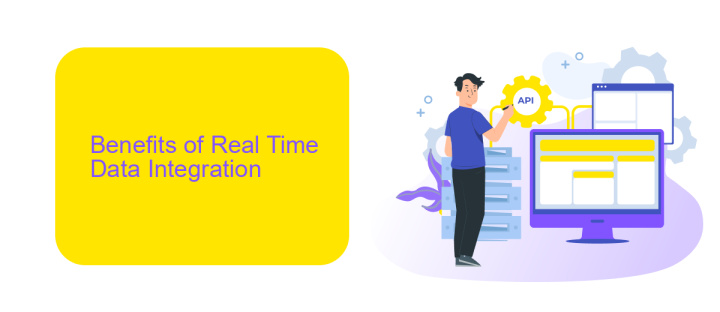Real Time Data Integration
In today's fast-paced digital landscape, real-time data integration has become essential for businesses seeking to maintain a competitive edge. By seamlessly merging data from various sources as it is generated, organizations can make informed decisions instantly, enhance operational efficiency, and improve customer experiences. This article explores the key benefits, challenges, and strategies for implementing real-time data integration effectively.
Introduction to Real Time Data Integration
Real-time data integration is a critical aspect of modern data management, enabling businesses to process and analyze data as soon as it is generated. This approach ensures that organizations can make timely decisions, improve operational efficiency, and gain a competitive edge. The continuous flow of data from various sources into a unified system is essential for maintaining up-to-date information across all business functions.
- Immediate data availability for decision-making
- Enhanced operational efficiency
- Improved customer experiences
- Scalability to handle large volumes of data
Tools like ApiX-Drive simplify the process of real-time data integration by offering seamless connectivity between various applications and services. ApiX-Drive allows businesses to automate data flows, ensuring that information is consistently synchronized across platforms without manual intervention. By leveraging such tools, organizations can focus more on strategic initiatives rather than the technical complexities of data integration.
Benefits of Real Time Data Integration

Real-time data integration offers significant advantages for businesses by enabling immediate access to up-to-date information. This facilitates faster decision-making, as stakeholders can rely on the most current data available. For example, sales teams can monitor customer interactions in real time, allowing them to adjust strategies and improve customer satisfaction promptly. Additionally, real-time data integration enhances operational efficiency by automating data flows between different systems, reducing the need for manual data entry and minimizing errors.
Moreover, real-time data integration supports better analytics and reporting. With tools like ApiX-Drive, businesses can seamlessly connect various data sources, ensuring that all relevant information is consolidated and readily accessible. This leads to more accurate and comprehensive insights, enabling organizations to identify trends and opportunities quickly. Furthermore, real-time integration helps maintain data consistency across platforms, ensuring that all departments are working with the same information, thereby fostering better collaboration and alignment within the organization.
Challenges in Implementing Real Time Data Integration

Implementing real-time data integration presents several challenges that organizations must navigate to ensure seamless data flow and accuracy. These challenges can hinder the effectiveness of data integration if not properly addressed.
- Data Consistency: Maintaining data consistency across multiple sources in real-time is complex and requires robust synchronization mechanisms.
- Latency Issues: Minimizing latency to ensure that data is transferred and processed in real-time can be difficult, especially with large datasets.
- Scalability: As data volumes grow, systems must scale efficiently without compromising performance.
- Security Concerns: Real-time data integration must ensure that data is securely transmitted and stored to prevent breaches.
- System Compatibility: Integrating diverse systems and platforms can be challenging due to varying data formats and protocols.
Services like ApiX-Drive can mitigate some of these challenges by offering automated integration solutions that support real-time data synchronization across various platforms. By leveraging such tools, organizations can enhance their data integration processes, ensuring higher efficiency and reliability.
Technologies for Real Time Data Integration

Real-time data integration is essential for businesses looking to leverage up-to-the-minute information for decision-making and operational efficiency. This process involves synchronizing data across multiple systems and platforms instantaneously, ensuring that all data repositories are updated without delay.
Several technologies facilitate real-time data integration, each offering unique advantages and features. These technologies range from data streaming platforms to integration services that automate data workflows and ensure seamless data flow between disparate systems.
- Apache Kafka: A distributed streaming platform that handles real-time data feeds with high throughput and low latency.
- Amazon Kinesis: A cloud-based service for real-time data processing, enabling scalable and durable data streaming.
- ApiX-Drive: A no-code integration service that allows users to connect various applications and automate data synchronization in real-time.
- Apache Flink: A stream processing framework for real-time data analytics, supporting complex event processing and stateful computations.
By leveraging these technologies, businesses can ensure that their data is always current and accessible, leading to more informed decisions and improved operational efficiency. Tools like ApiX-Drive simplify the integration process, making it accessible even for users without technical expertise.
Use Cases for Real Time Data Integration
Real-time data integration is pivotal for industries requiring immediate data processing and insights. In e-commerce, it enables dynamic inventory management and personalized customer experiences by synchronizing sales data, stock levels, and customer preferences across platforms instantaneously. Financial services leverage real-time data integration to monitor transactions, detect fraud, and manage risk in real-time, ensuring compliance and enhancing decision-making processes.
Healthcare systems benefit from real-time data integration by providing timely access to patient records, improving diagnosis accuracy, and streamlining treatment plans. Tools like ApiX-Drive simplify the integration process, allowing businesses to connect disparate systems and automate data flows without extensive coding. This facilitates seamless data exchange and operational efficiency across various applications, ensuring that critical information is always up-to-date and readily available.
FAQ
What is Real Time Data Integration?
Why is Real Time Data Integration important for businesses?
What are the common challenges faced in Real Time Data Integration?
How can businesses implement Real Time Data Integration effectively?
What are the benefits of using automation tools for Real Time Data Integration?
Routine tasks take a lot of time from employees? Do they burn out, do not have enough working day for the main duties and important things? Do you understand that the only way out of this situation in modern realities is automation? Try Apix-Drive for free and make sure that the online connector in 5 minutes of setting up integration will remove a significant part of the routine from your life and free up time for you and your employees.

